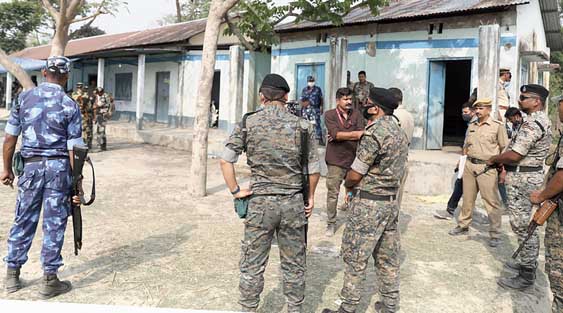Will Modi-Shah meet their Waterloo in the West Bengal elections?
![In the midst of a war of words between Indian Home Minister Amit Shah and Prime Minister Narendra Modi on one side and Trinamool Congress chief and incumbent Chief Minister Mamta Banerjee on the other, the bravado of the right-wing Bharatiya Janta Party is visible. Political analyst and observer Kumar Sanjay Singh, argues that there are enough pointers that despite their well-oiled election machine, the Cooch Behar violence following internecine factionalism, the party may still eat humble pie when results […]](https://www.theworldsikhnews.com/wp-content/uploads/2021/04/Cooch-firing-360x266.jpg)
In the midst of a war of words between Indian Home Minister Amit Shah and Prime Minister Narendra Modi on one side and Trinamool Congress chief and incumbent Chief Minister Mamta Banerjee on the other, the bravado of the right-wing Bharatiya Janta Party is visible. Political analyst and observer Kumar Sanjay Singh, argues that there are enough pointers that despite their well-oiled election machine, the Cooch Behar violence following internecine factionalism, the party may still eat humble pie when results pour in for the multi-round West Bengal polls.
IT WOULD NOT BE AN EXAGGERATION to suggest that Modi and Shah have redefined the art of electioneering in Indian politics. Their single-minded pursuit of electoral victory, meticulous planning to expand BJP’s social and geographical base through organizational alliances and social engineering, and finally the micromanagement of elections down to the booth level, have not been witnessed before. The duo is now faced with the hour of reckoning in the West Bengal and Assam assembly election 2021.
Amit Shah and Modi have publicly ridiculed Mamta Banerjee’s letter to a section of the opposition parties highlighting the current assembly election as a watershed moment for Indian democracy. However, both of them understand the singular political significance of assembly elections in West Bengal and Assam. The result of these two elections will have a significant impact on the BJP’s effort to expand in the eastern and northeastern states of India. A move that has acquired an urgency with the expected erosion of BJP’s support in North and western India.
BJP’s political style is founded on masculine chest-thumping. The claim of having a 56 inches chest by Narendra Modi, acquires socio-political significance in the backdrop of a muscular political culture patronized and promoted by the BJP.
 BJP’s political style is founded on masculine chest-thumping. The claim of having a 56 inches chest by Narendra Modi, acquires socio-political significance in the backdrop of a muscular political culture patronized and promoted by the BJP.
BJP’s political style is founded on masculine chest-thumping. The claim of having a 56 inches chest by Narendra Modi, acquires socio-political significance in the backdrop of a muscular political culture patronized and promoted by the BJP.
BJP’s campaign involving a lot of chest-thumping and masochistic vitriol is, therefore, par for the course of their politics. However, if we look beyond this mist of propaganda and bravado we might witness a deeply worried BJP speculating the political costs of a below-par performance in the assembly elections in Assam and West Bengal. Here we will confine our observations to Bengal.
Information from the ground in Bengal does not paint a very rosy picture for BJP’s poll prospects. Information gleaned from the reportage on Bengal polls presents a picture opposite to the drumbeating by the BJP leadership.
In phases, one and two, BJP has an upper hand but not by much. BJP has underperformed in Jungle Mahal. This explains why the influential tribal leader Chakradhar Mahto, who upon his release on bail on charges of commandeering a train joined TMC, was rearrested by the NIA.
TMC has maintained its past performance in phases three and four. It’s to be noted that Cooch Behar, which went to the polls in phase four, witnessed violent clashes between the old and the new BJP in the run-up to the polls.
BJP may live to regret the death of five youth in Cooch Behar.
BJP may live to regret the death of five youth in Cooch Behar. This firing will result in the consolidation of the minority votes thereby undermining the possibility of AIMIM and ISF weaning votes away from Trinamool Congress. Since firing was resorted to in the first half of 10 April, between 10.00 am to 10.30 am, it must have impacted voting trends even on 10 April too. It is bound to have a significant impact in Murshidabad, Haldia and Malda districts, that go to polls in the sixth to eighth phase.
The firing that will remind the bad old days of police excesses beginning from the 1970s to Nandigram and Singur may turn a section of 45-plus voters away from the BJP. Such events of excesses have left an indelible scar on the psyche of the Bengali middle class which has been mythologized in cultural productions such as Hazar Chaurasi ki Maa.

Eventually, therefore, the BJP’s electoral performance will fall far short of the highs it reached in 2019 parliamentary polls. It’s necessary to underscore here that in the Lok Sabha elections, BJP increased its poll percentage by eating into the Left-Congress votes. This may not be repeated in the ongoing assembly elections as the Left and Congress have managed a pretty impressive campaign and are poised to win back a substantial proportion of its voters that had been lost to the BJP.
The biggest impediment to the BJP’s poll prospects is its organizational weakness. Lacking an organizational structure in rural Bengal, the BJP went overboard in engineering defections from TMC.
Evidently, their success in this endeavour fell far short of the hype created by Amit Shah, who had claimed repeatedly from various public fora that Didi -(read sister, as Mamta Banerjee is popularly known to her party folks and the general public in West Bengal) will be left alone when polls commence. Notwithstanding, a clutch of high-value defections, the TMC organizational structure was left unscathed.
BJP, which is otherwise synonymous with a rigidly disciplined political party with a well-defined structure of command, is facing a formidable electoral machine of TMC, with an organization that doesn’t have strong local leadership and is riven with factions.
 The impact of these defections, however, were notoriously destabilizing for the BJP. There were open rebellions in the BJP against the recent imports. The festering wound of factional fights erupted in full public view in Cooch Behar. Less dramatic but equally significant were the silent defiance and non-cooperation of the BJP rank and file which compelled the central leadership to change their chosen candidate on more than one occasions. Evidently, the BJP central leadership was so hobbled, by these factional fights, that it had to field 4 MP’s in the assembly polls. It was also compelled to stagger the declaration of the list of candidates thereby losing precious time for the campaign.
The impact of these defections, however, were notoriously destabilizing for the BJP. There were open rebellions in the BJP against the recent imports. The festering wound of factional fights erupted in full public view in Cooch Behar. Less dramatic but equally significant were the silent defiance and non-cooperation of the BJP rank and file which compelled the central leadership to change their chosen candidate on more than one occasions. Evidently, the BJP central leadership was so hobbled, by these factional fights, that it had to field 4 MP’s in the assembly polls. It was also compelled to stagger the declaration of the list of candidates thereby losing precious time for the campaign.
The value of a well oiled organizational structure cannot be underestimated in an election. Even if anti-incumbency exists against a state government, as is the case in Bengal, an extensive organizational structure is required to convert public disenchantment into votes. Conversely, an organization that is a divided house fails at the hustings.
The case in point being Tripura were a divided BJP, which had to face 11 rebel candidates in a 30 member (of which 28 went to polls) Tripura Tribal Areas Autonomous District Council (TTAADC), lost to The TIPRA Motha, led by royal scion Pradyot Kishore Manikya Debbarma. To add insult to the injury of a humiliating defeat, it may be noted that TIPRA was formed just two months before the ADC election.
BJP, which is otherwise synonymous with a rigidly disciplined political party with a well-defined structure of command, is facing a formidable electoral machine of TMC, with an organization that doesn’t have strong local leadership and is riven with factions.
It wouldn’t be unreasonable to speculate that BJP in Bengal assembly elections may suffer the same fate as in Tripura.
 Print
Print

 54
54


One thought on “Will Modi-Shah meet their Waterloo in the West Bengal elections?”